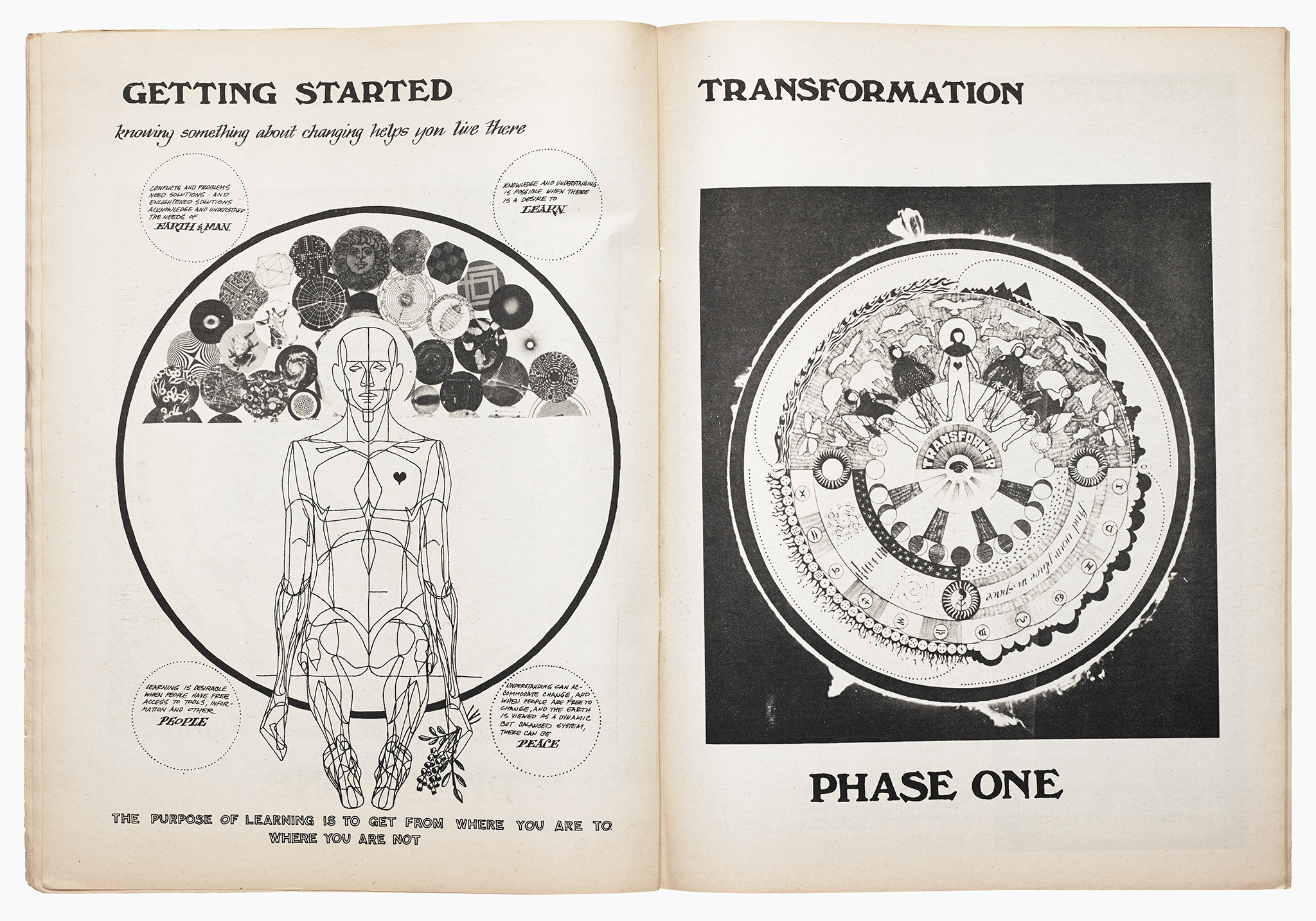Sustainabilities: Eco-oriented | Utopian

Members of East Totem West poster group displaying mandalas, San Francisco, 1967 (PETER LARSEN/REX USA)
Mandalas hark from Hindu, Buddhist, and Jain religions traditions in Asia. They are used as visual aids to guide meditation and practice, mark sacred ground, or to represent spheres of influences and unfolding patterns related to abstract and complex cosmographies. The world “mandala” translates as “circle,” but mandalas can reflect more abstract ideas of order and transformation.
Mandalas entered into European and American popular culture largely through the writings of Carl Jung, who took them up as a personal and professional practice in 1916.1 Jung presented mandalas as devises for “individuation,” or bringing the self into harmony with the world. This idea was picked up by writers such as Joseph Campbell and Mircea Eliade, both of whom presented the mandala as a circle, and further following on the work of Jung, as an archetype for “the whole.” These approaches highlighted the mandala as a universal form, divorcing it from its rich symbolic groundings and the rigorous training involved in using mandalas to induct novices into a lineage of students and teachers. Jung’s presentation of mandalas suggested a more personal approach to the ritual of their production. In the process, mandalas lost some of their embedded religious and cultural significance and a deeper connection to specific locales, allowing them to be picked up globally and used in innovative ways by groups that chose to either acknowledge or elide their history.
Joining the eclectic collection of references that made up the counterculture of Northern California—from psychedelics and cybernetics, to communal living and Eastern religions—the mandala became an often-repeated formal device beginning in the 1960s. Mandalas were everywhere in California: They could be found in the book shops and head shops of San Francisco and Berkeley, in posters for Trips Fests and Be-Ins, the new visual work of artists like James Whitney, the trippy posters of East Totem West, and later in new ecological visualizations.2 As Gordon Ashby, an influential designer practicing in San Francisco in the 1960s and ’70s put it, mandalas offered a unique visual devise for holding multiple, diverse references and experiences within a single image; a countercultural image for “the whole thing.”3

Gordon Ashby's mandala-inspired images of personal and global transformation, from Whole Earth Catalog, July 1970
In 1970, Gordon Ashby produced a set of mandalas for the Whole Earth Catalog. Comprising a special insert titled “Finding Your Place in Space,” they were some of the first widely available mandalas to present an ecological perspective. Grounded in the experiences and discoveries of Northern California’s unique counterculture, they not only described humanity’s place in space, but proposed a radical vision for global and personal transformation as a way towards social and environmental harmony; a vision for a new human-centered ecology.4
At UC Berkeley, artists and architects began experimenting with these new ideas and incorporating mandalas into their courses and work. Sim Van der Ryn, a friend and colleague of Gordon Ashby and founder of the Farallones Institute, lead several courses along with Jim Campe and Carl Anthony.5 As part of one course, they produced the Natural Energy Design Work Book, a guide to ecological living and design. It features a set of mandalas diagraming an integrated architecture and model for sustainable design premised on the idea of the house “plugged into” complete and whole systems.
The work that perhaps best embodies the many facets of the countercultures’ approach to mandalas is José and Miriam Argüelles’s Mandala. It joined a set of texts found on many countercultural bookshelves, which included the wildly popular I-Ching and the Tibetan Book of the Dead, both of which feature introductions by Carl Jung in their original editions. The Argüelles’s Mandala portrays the mandala as a device for finding and visualizing personal and universal harmony. Amidst their personal mandalas are images and quotes drawn from around the world, bibliographies on text related to the mandala, and even a picture of the earth from space — a dominant visual trope of both the environmental movement and the Whole Earth Catalog network. Two years before writing Mandala, José Argüelles founded the Whole Earth Festival, which is still held as an annual event on the University of California Davis campus. It is a fitting example of how the mandala as a visualization tactic was integral to countercultural efforts to change the world through the combined pursuit of personal liberation and ecological holism. So popular and powerful was this new Californian use of the mandala that it was easy to forget the symbol's Asian origins, and its ongoing and quite distinct significance for particular places, cultures, and forms of religious practice.
— Padma Maitland
1. Carl Gustav Jung and Richard Francis Carrington Hull, Mandala Symbolism, (Princeton, NJ: Princeton University Press, 1973).
2. For more on the many diagrams of the counterculture, see Simon Sadler’s “Diagrams of Countercultural Architecture.” Design and Culture 4, no. 3 (2012): 345–67.
3. Personal interview, 2014.
4. Greg Castillo, “Hippie Modernism,” Places Journal, October 26, 2015.
5. For more on Sim Van der Ryn’s approaches to ecological design, see Sim Van der Ryn and Stuart Cowan, Ecological Design, Tenth Anniversary Edition (Washington, DC: Island Press, 2007) and Sim Van der Ryn, Design For Life: The Architecture of Sim Van der Ryn</emm (Layton, UT: Gibbs Smith, 2005).
Published March 25, 2016

